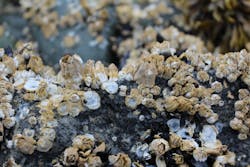Blood-repelling tissue glue could seal wounds quickly
Inspired by the sticky substance that barnacles use to cling to rocks, MIT engineers have designed a strong, biocompatible glue that can seal injured tissues and stop bleeding.
The new paste can adhere to surfaces even when they are covered with blood, and can form a tight seal within about 15 seconds of application. Such a glue could offer a much more effective way to treat traumatic injuries and to help control bleeding during surgery, the researchers say.
“We are solving an adhesion problem in a challenging environment, which is this wet, dynamic environment of human tissues. At the same time, we are trying to translate this fundamental knowledge into real products that can save lives,” says Xuanhe Zhao, a professor of mechanical engineering and civil and environmental engineering at MIT and one of the senior authors of the study.
Christoph Nabzdyk, a cardiac anesthesiologist and critical care physician at the Mayo Clinic in Rochester, Minnesota, is also a senior author of the paper, which appears today in Nature Biomedical Engineering. MIT Research Scientist Hyunwoo Yuk and postdoc Jingjing Wu are the lead authors of the study.
Finding ways to stop bleeding is a longstanding problem that has not been adequately solved, Zhao says. Sutures are commonly used to seal wounds, but putting stitches in place is a time-consuming process that usually isn’t possible for first responders to perform during an emergency situation. Among members of the military, blood loss is the leading cause of death following a traumatic injury, and among the general population, it is the second leading cause of death following a traumatic injury.
In recent years, some materials that can halt bleeding, also called hemostatic agents, have become commercially available. Many of these consist of patches that contain clotting factors, which help blood to clot on its own. However, these require several minutes to form a seal and don’t always work on wounds that are bleeding profusely.
For their new tissue glue, the researchers once again drew inspiration from the natural world. This time, they focused their attention on the barnacle, a small crustacean that attaches itself to rocks, ship hulls, and even other animals such as whales. These surfaces are wet and often dirty — conditions that make adhesion difficult.
The researchers’ analysis of barnacle glue revealed that it has a unique composition. The sticky protein molecules that help barnacles attach to surfaces are suspended in an oil that repels water and any contaminants found on the surface, allowing the adhesive proteins to attach firmly to the surface.
The MIT team decided to try to mimic this glue by adapting an adhesive they had previously developed. This sticky material consists of a polymer called poly(acrylic acid) embedded with an organic compound called an NHS ester, which provides adhesion, and chitosan, a sugar that strengthens the material. The researchers froze sheets of this material, ground it into microparticles, and then suspended those particles in medical grade silicone oil.
When the resulting paste is applied to a wet surface such as blood-covered tissue, the oil repels the blood and other substances that may be present, allowing the adhesive microparticles to crosslink and form a tight seal over the wound. Within 15 to 30 seconds of applying the glue, with gentle pressure applied, the glue sets and bleeding stops, the researchers showed in tests in rats.
Their studies showed that the seal remains intact for several weeks, giving the tissue below time to heal itself, and that the glue induced little inflammation, similar to that produced by currently used hemostatic agents. The glue is slowly resorbed within the body over months, and it can also be removed earlier by applying a solution that dissolves it, if surgeons need to go in after the initial application to repair the wound.
The researchers now plan to test the glue on larger wounds, which they hope will demonstrate that the glue would be useful to treat traumatic injuries. They also envision that it could be useful during surgical procedures, which often require surgeons to spend a great deal of time controlling bleeding.
